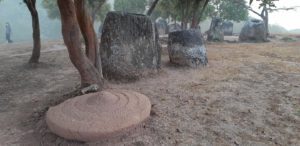
UNIVERSITY OF MELBOURNE—New research conducted at the UNESCO World Heritage listed ‘Plain of Jars’ in Laos has established the stone jars were likely placed in their final resting position from as early as 1240 to 660 BCE.
Sediment samples from beneath stone jars from two of the more than 120 recorded megalithic sites were obtained by a team led Dr Louise Shewan from the University of Melbourne, Associate Professor Dougald O’Reilly from the Australian National University (ANU) and Dr Thonglith Luangkoth from the Lao Department of Heritage.
The samples were analyzed using a technique called Optically Stimulated Luminescence (OSL) to determine when sediment grains were last exposed to sunlight.
“With these new data and radiocarbon dates obtained for skeletal material and charcoal from other burial contexts, we now know that these sites have maintained enduring ritual significance from the period of their initial jar placement into historic times,” Dr Shewan said.
The megalithic jar sites in Northern Laos comprise one to three-meter-tall carved stone jars, weighing up to 20 tonnes, dotted across the landscape, appearing alone or in groups of up to several hundred.
Dr Shewan and her team completed their most recent excavations in March 2020, revisiting Site 1 (Ban Hai Hin), and arriving back in Australia just before global pandemic international boarder closures.
Site 1 revealed more burials placed around the jars and confirmed earlier observations that the exotic boulders distributed across the site are markers for ceramic burial jars buried below.
Published today in PLOS One, Dr Shewan and collaborators present new radiocarbon results for site use and also introduce geochronological data determining the likely quarry source for one of the largest megalithic sites.
While geologists have used detrital zircon U-Pb dating for several decades, this methodology has recently been used to establish the provenance of ceramic and stone sources in archaeological contexts including Stonehenge.
Conducted at ANU by Associate Professor Richard Armstrong, the U-Pb zircon ages measured in jar samples from Site 1 were compared to potential source material, including a sandstone outcrop and an incomplete jar from a presumed quarry located some 8km away. The zircon age distributions revealed very similar provenance suggesting that this outcrop was the likely source of the material used for the creation of jars at the site.
“How the jars were moved from the quarry to the site, however, remains a mystery,” Associate Professor O’Reilly said.
The next challenge for the researchers is to obtain further samples from other sites and from across the geographic expanse of this megalithic culture to understand more about these enigmatic sites and the period over which they were created.
Dr Shewan said this is not an especially easy task given the extensive unexploded ordnance (UXO) contamination in the region where less than 10 per cent of the known jar sites have been cleared.
“We expect that this complex process will eventually help us share more insights into what is one of Southeast Asia’s most mysterious archaeological cultures.”
The full team of researchers includes La Trobe University, James Cook University, University of Gloucestershire and international collaborators from Laos, New Zealand and Hong Kong.
_____________________________

Dr Shewan and collaborators present new radiocarbon results for site use and also introduce geochronological data determining the likely quarry source for one of the largest megalithic sites. Plain of Jars Archaeological Research Project
_____________________________
Article Source: UNIVERSITY OF MELBOURNE news release
_____________________________
Advertisement



